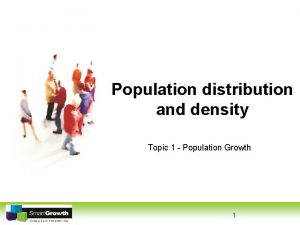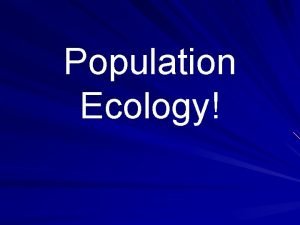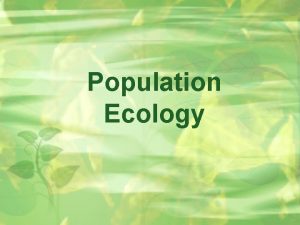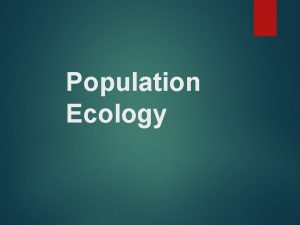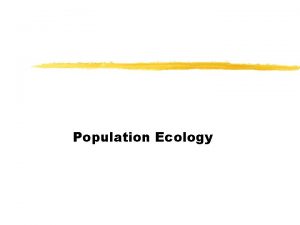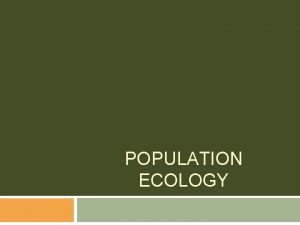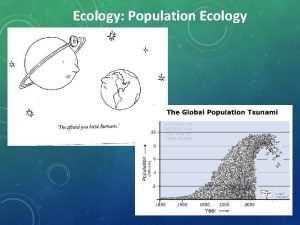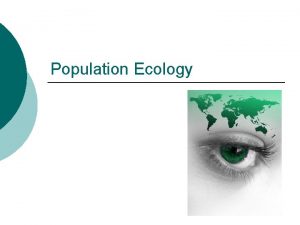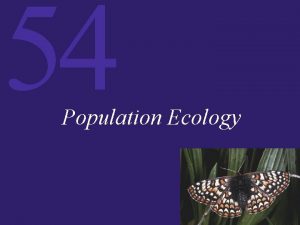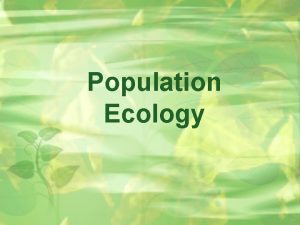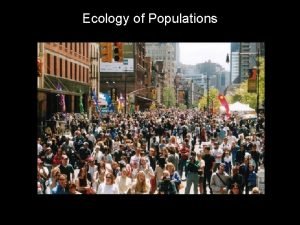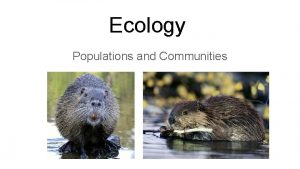Population Ecology Populations Population all individuals of 1




















- Slides: 20

Population Ecology!

Populations Population: all individuals of 1 species in area Population size : number of individuals Population density : number per area Population distribution : dispersal pattern

Distribution patterns 1) Clumped: most common, a) group around resources b) social behavior c) lack of offspring dispersal 2) Uniform (or close enough) a) territory division 3) Random – rare a) uniform resources b) ignore each other

Population Size Estimates 1) full count 2) Quadrats 3) Transects 4) Mark-recapture m-r good for organisms that move around a lot

Mark-recapture Based on assumption: % marked on day 2 same as the % of the total population that is marked Steps: day 1 capture organisms & mark them day 2 capture organisms & see what % are marked calculation day 2 marked = day 1 marked day 2 total population

Population Growth Positive growth ……. . birth & immigration Negative growth …… death & emigration Migration : periodic change w/ seasons Net reproduction = births – deaths Per capita = per individual Doubling time: time for pop to double size

Rapid Population Growth Exponential growth : population grows at a rate proportional to its size a) ideal conditions allow max growth rate Biotic potential : max growth rate for a population (under ideal conditions)

Logistic Population Growth Exponential Growth slowed by 1) Density dependent limiting factors predation, parasites, disease limited resources, competition 2) Density independent limiting factors weather, natural disasters, humans


Carrying capacity = Max # individuals an area can support indefinitely (D) Steady state #2 on graph Life history patterns: adaptations that influence survival, reproduction & population size

Life History Patterns r-selected a) favor low pop density (d independent) b) quick production of many small babies c) high biotic potential so called r-selected K-selected a) favor high pop density (d dependent) b) good competitors c) low biotic potential & parental care

Life History Strategies

Different Life Histories = Different Survivorship Curves Type I : live long & prosper (parental care) k-selected Type II : could die at any time… good luck Type III : high infant mortality r-selected


Human Population growth to 2 billion…………. . 123 years Growth to 3 billion …………. 33 years Growth to 4, 5, 6 …………. . 14, 13, 12

Fertility Rates and $$$$$$$ Total Fertility Rate (TFR) – average # children born per woman World wide TFR = 6. 5 Replacement = 2. 1 TFR in developed countries = at or below 2. 1 TFR in developing countries = highest

Demographic Transition Model



 Individuals don't evolve populations do
Individuals don't evolve populations do Population ecology section 1 population dynamics
Population ecology section 1 population dynamics Population ecology section 1 population dynamics
Population ecology section 1 population dynamics Population ecology section 1 population dynamics
Population ecology section 1 population dynamics Chapter 4 section 1 population dynamics study guide answers
Chapter 4 section 1 population dynamics study guide answers Clumped dispersion
Clumped dispersion Exponential growth equation ecology
Exponential growth equation ecology Population vs community ecology
Population vs community ecology Population vs community ecology
Population vs community ecology Concept 3 population ecology
Concept 3 population ecology Chapter 53 population ecology
Chapter 53 population ecology Equilibrial life history
Equilibrial life history Ecology
Ecology Survivorship curve def
Survivorship curve def Chapter 53 population ecology
Chapter 53 population ecology Population characteristic
Population characteristic Chapter 4 population ecology answer key
Chapter 4 population ecology answer key Population characteristics
Population characteristics What is population ecology
What is population ecology Population definition ecology
Population definition ecology Population distribution
Population distribution




















